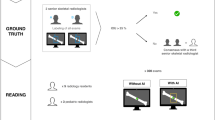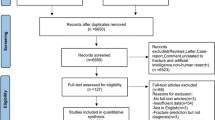Abstract
Objectives
To evaluate the diagnostic accuracy of artificial intelligence-based algorithms in identifying neck of femur fracture on a plain radiograph.
Design
Systematic review and meta-analysis.
Data sources
PubMed, Web of science, Scopus, IEEE, and the Science direct databases were searched from inception to 30 July 2023.
Eligibility criteria for study selection
Eligible article types were descriptive, analytical, or trial studies published in the English language providing data on the utility of artificial intelligence (AI) based algorithms in the detection of the neck of the femur (NOF) fracture on plain X-ray.
Main outcome measures
The prespecified primary outcome was to calculate the sensitivity, specificity, accuracy, Youden index, and positive and negative likelihood ratios. Two teams of reviewers (each consisting of two members) extracted the data from available information in each study. The risk of bias was assessed using a mix of the CLAIM (the Checklist for AI in Medical Imaging) and QUADAS-2 (A Revised Tool for the Quality Assessment of Diagnostic Accuracy Studies) criteria.
Results
Of the 437 articles retrieved, five were eligible for inclusion, and the pooled sensitivity of AIs in diagnosing the fracture NOF was 85%, with a specificity of 87%. For all studies, the pooled Youden index (YI) was 0.73. The average positive likelihood ratio (PLR) was 19.88, whereas the negative likelihood ratio (NLR) was 0.17. The random effects model showed an overall odds of 1.16 (0.84–1.61) in the forest plot, comparing the AI system with those of human diagnosis. The overall heterogeneity of the studies was marginal (I2 = 51%). The CLAIM criteria for risk of bias assessment had an overall >70% score.
Conclusion
Artificial intelligence (AI)-based algorithms can be used as a diagnostic adjunct, benefiting clinicians by taking less time and effort in neck of the femur (NOF) fracture diagnosis.
Study registration
PROSPERO CRD42022375449.




Similar content being viewed by others
References
Augat, P., Bliven, E., & Hackl, S. (2019). Biomechanics of femoral neck fractures and implications for fixation. Journal of Orthopaedic Trauma, 33(Suppl 1), S27–S32. https://doi.org/10.1097/BOT.0000000000001365
Gullberg, B., Johnell, O., & Kanis, J. A. (1997). World-wide projections for hip fracture. Osteoporosis International, 7(5), 407–413. https://doi.org/10.1007/pl00004148
Pinto, A., Berritto, D., Russo, A., Riccitiello, F., Caruso, M., Belfiore, M. P., Papapietro, V. R., Carotti, M., Pinto, F., Giovagnoni, A., & Romano, L. (2018). Traumatic fractures in adults: missed diagnosis on plain radiographs in the emergency department. Acta Biomed., 89(1-S), 111–123. https://doi.org/10.23750/abm.v89i1-S.7015
Guly, H. R. (2001). Diagnostic errors in an accident and emergency department. Emergency Medicine Journal, 18(4), 263–269. https://doi.org/10.1136/emj.18.4.263
Miele, V., Galluzzo, M., & Trinci, M. (2012). Missed fractures in the emergency department. InErrors in radiology (pp. 39–50). Milano: Springer. https://doi.org/10.1007/978-88-470-2339-0_5l
Brady, A. P. (2017). Error and discrepancy in radiology: inevitable or avoidable? Insights Imaging., 8(1), 171–182. https://doi.org/10.1007/s13244-016-0534-1
Waite, S., Scott, J., Gale, B., Fuchs, T., Kolla, S., & Reede, D. (2017). Interpretive error in radiology. AJR. American Journal of Roentgenology, 208(4), 739–749. https://doi.org/10.2214/AJR.16.16963
Degnan, A. J., Ghobadi, E. H., Hardy, P., Krupinski, E., Scali, E. P., Stratchko, L., Ulano, A., Walker, E., Wasnik, A. P., & Auffermann, W. F. (2019). Perceptual and interpretive error in diagnostic radiology-causes and potential solutions. Academic Radiology, 26(6), 833–845. https://doi.org/10.1016/j.acra.2018.11.006
Tang, X. (2019). The role of artificial intelligence in medical imaging research. BJR Open., 2(1), 20190031. https://doi.org/10.1259/bjro.20190031
Aggarwal, R., Sounderajah, V., Martin, G., Ting, D. S., Karthikesalingam, A., King, D., Ashrafian, H., & Darzi, A. (2021). Diagnostic accuracy of deep learning in medical imaging: A systematic review and meta-analysis. NPJ Digital Medicine., 4(1), 1–23. https://doi.org/10.1038/s41746-021-00438-z
Pesapane, F., Codari, M., & Sardanelli, F. (2018). Artificial intelligence in medical imaging: Threat or opportunity? Radiologists again at the forefront of innovation in medicine. European Radiology Experimental, 2, 35. https://doi.org/10.1186/s41747-018-0061-6
Puttagunta, M., & Ravi, S. (2021). Medical image analysis based on deep learning approach. Multimed Tools Appl., 80(16), 24365–24398. https://doi.org/10.1007/s11042-021-10707-4
Fourcade, A., & Khonsari, R. H. (2019). Deep learning in medical image analysis: A third eye for doctors. J Stomatol Oral Maxillofac Surg., 120(4), 279–288. https://doi.org/10.1016/j.jormas.2019.06.002
Kuo, R. Y. L., Harrison, C., Curran, T. A., Jones, B., Freethy, A., Cussons, D., Stewart, M., Collins, G. S., & Furniss, D. (2022). Artificial intelligence in fracture detection: A systematic review and meta-analysis. Radiology., 304(1), 50–62. https://doi.org/10.1148/radiol.211785
Groot, O. Q., Bongers, M. E. R., Ogink, P. T., Senders, J. T., Karhade, A. V., Bramer, J. A. M., Verlaan, J. J., & Schwab, J. H. (2020). Does artificial intelligence outperform natural intelligence in interpreting musculoskeletal radiological studies? A systematic review. Clinical Orthopaedics and Related Research, 478(12), 2751–2764. https://doi.org/10.1097/CORR.0000000000001360
Zhang, X., Yang, Y., Shen, Y. W., Zhang, K. R., Jiang, Z. K., Ma, L. T., Ding, C., Wang, B. Y., Meng, Y., & Liu, H. (2022). Diagnostic accuracy and potential covariates of artificial intelligence for diagnosing orthopedic fractures: A systematic literature review and meta-analysis. European Radiology, 32(10), 7196–7216. https://doi.org/10.1007/s00330-022-08956-4
Langerhuizen, D. W. G., Janssen, S. J., Mallee, W. H., van den Bekerom, M. P. J., Ring, D., Kerkhoffs, G. M. M. J., Jaarsma, R. L., & Doornberg, J. N. (2019). What are the applications and limitations of artificial intelligence for fracture detection and classification in orthopaedic trauma imaging? A systematic review. Clinical Orthopaedics and Related Research, 477(11), 2482–2491. https://doi.org/10.1097/CORR.0000000000000848
Olczak, J., Fahlberg, N., Maki, A., Razavian, A. S., Jilert, A., Stark, A., Sköldenberg, O., & Gordon, M. (2017). Artificial intelligence for analyzing orthopedic trauma radiographs. Acta Orthop., 88(6), 581–586. https://doi.org/10.1080/17453674.2017.1344459
Adams, M., Chen, W., Holcdorf, D., McCusker, M. W., Howe, P. D., & Gaillard, F. (2019). Computer vs human: Deep learning versus perceptual training for the detection of neck of femur fractures. Journal of medical imaging and radiation oncology., 63(1), 27–32. https://doi.org/10.1111/1754-9485.12828
Mu, L., Qu, T., Dong, D., Li, X., Pei, Y., Wang, Y., Shi, G., Li, Y., He, F., & Zhang, H. (2021). Fine-tuned deep convolutional networks for the detection of femoral neck fractures on pelvic radiographs: A multicenter dataset validation. IEEE Access., 24(9), 78495–78503. https://doi.org/10.1109/ACCESS.2021.3082952
Beyaz, S., Açıcı, K., & Sümer, E. (2020). Femoral neck fracture detection in X-ray images using deep learning and genetic algorithm approaches. Jt Dis Relat Surg., 31(2), 175–183. https://doi.org/10.5606/ehc.2020.72163
Mutasa, S., Varada, S., Goel, A., Wong, T. T., & Rasiej, M. J. (2020). Advanced deep learning techniques applied to automated femoral neck fracture detection and classification. Journal of Digital Imaging, 33(5), 1209–1217. https://doi.org/10.1007/s10278-020-00364-8
Bae, J., Yu, S., Oh, J., Kim, T. H., Chung, J. H., Byun, H., Yoon, M. S., Ahn, C., & Lee, D. K. (2021). External validation of deep learning algorithm for detecting and visualizing femoral neck fracture including displaced and non-displaced fracture on plain X-ray. J Digit Imaging., 34(5), 1099–1109. https://doi.org/10.1007/s10278-021-00499-2
QUADAS-C tool | Cochrane Methods [Internet]. [cited 2023 Jan 1]. Available from: https://methods.cochrane.org/methods-cochrane/quadas-c-tool
Mongan, J., Moy, L., & Kahn, C. E., Jr. (2020). Checklist for artificial intelligence in medical imaging (CLAIM): A guide for authors and reviewers. Radiol Artif Intell., 2(2), e200029. https://doi.org/10.1148/ryai.2020200029
Chen, W., HolcDorf, D., McCusker, M. W., Gaillard, F., & Howe, P. D. L. (2017). Perceptual training to improve hip fracture identification in conventional radiographs. PLoS ONE, 12(12), e0189192. https://doi.org/10.1371/journal.pone.0189192
Cha, Y., Kim, J. T., Park, C. H., Kim, J. W., Lee, S. Y., & Yoo, J. I. (2022). Artificial intelligence and machine learning on diagnosis and classification of hip fracture: Systematic review. Journal of Orthopaedic Surgery and Research, 17(1), 520. https://doi.org/10.1186/s13018-022-03408-7
Shelmerdine, S. C., White, R. D., Liu, H., Arthurs, O. J., & Sebire, N. J. (2022). Artificial intelligence for radiological paediatric fracture assessment: A systematic review. Insights Into Imaging, 13(1), 94. https://doi.org/10.1186/s13244-022-01234-3
Yang, S., Yin, B., Cao, W., Feng, C., Fan, G., & He, S. (2020). Diagnostic accuracy of deep learning in orthopaedic fractures: A systematic review and meta-analysis. Clinical Radiology, 75(9), 713.e17-713.e28. https://doi.org/10.1016/j.crad.2020.05.021
Funding
None.
Author information
Authors and Affiliations
Corresponding author
Ethics declarations
Conflict of Interest
All authors have completed the ICMJE uniform disclosure form at www.icmje.org/disclosure-of-interest/ and declare: no support from any organization for the submitted work; no financial relationships with any organizations that might have an interest in the submitted work in the previous three years; no other relationships or activities that could appear to have influenced the submitted work.
Ethical Approval
Not required.
Informed Consent
For this type of study informed consent is not required.
Additional information
Publisher's Note
Springer Nature remains neutral with regard to jurisdictional claims in published maps and institutional affiliations.
Supplementary Information
Below is the link to the electronic supplementary material.
Rights and permissions
Springer Nature or its licensor (e.g. a society or other partner) holds exclusive rights to this article under a publishing agreement with the author(s) or other rightsholder(s); author self-archiving of the accepted manuscript version of this article is solely governed by the terms of such publishing agreement and applicable law.
About this article
Cite this article
Raj, M., Ayub, A., Pal, A.K. et al. Diagnostic Accuracy of Artificial Intelligence-Based Algorithms in Automated Detection of Neck of Femur Fracture on a Plain Radiograph: A Systematic Review and Meta-analysis. JOIO 58, 457–469 (2024). https://doi.org/10.1007/s43465-024-01130-6
Received:
Accepted:
Published:
Issue Date:
DOI: https://doi.org/10.1007/s43465-024-01130-6




